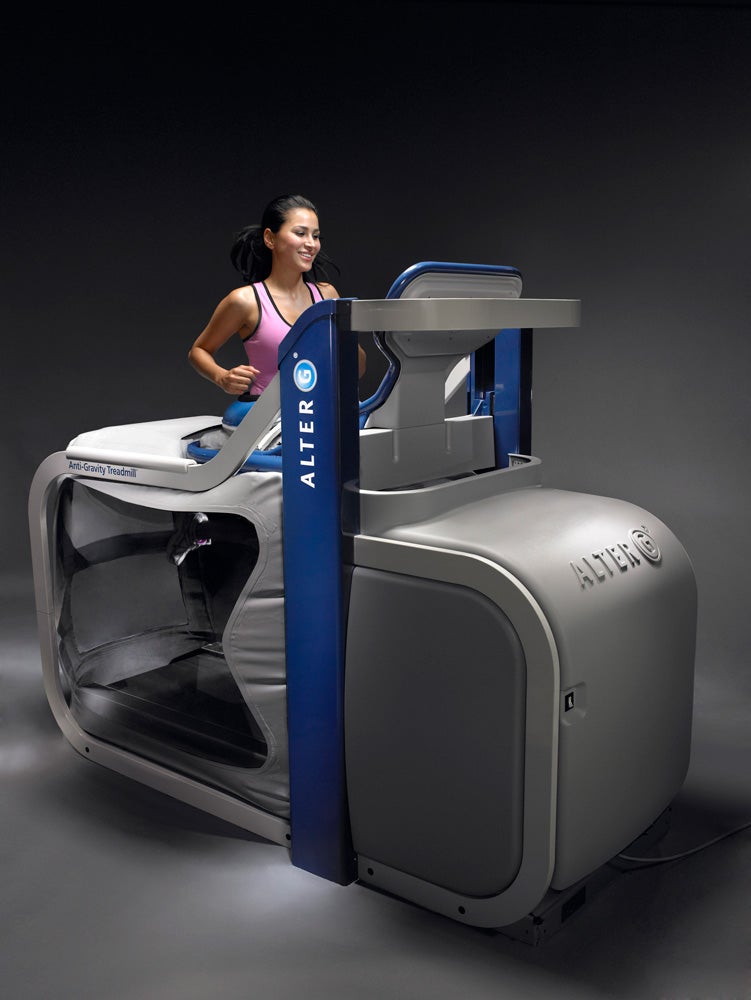Training Tip: Tread Lightly

The AlterG treadmill allows injured runners to train weightlessly and healthy athletes to boost speed.
Instead of heading to the pool for another round of water running, injured athletes are increasingly hitting the treadmill—the anti-gravity treadmill, or AlterG.
The AlterG uses “lower body positive pressure,” says AlterG spokesman Gabe Griego, to allow runners to run weight-free. That’s a fancy way of saying your legs—inside neoprene shorts—are zipped into a bubble over the treadmill and pressurized air is pumped in, pushing your body up and effectively lowering your body weight.
Weight sensors in the treadmill allow the AlterG to be operated at anywhere from 20–100 percent of the runner’s body weight, allowing an athlete to run with almost no impact.
The implications of impact-free running are obvious to anyone suffering from the stress of too much mileage. Those implications were also obvious to legendary coach Alberto Salazar when he saw a prototype in the mid-2000s.
Robert Whalen was a NASA scientist who helped develop negative pressure technology, the reverse of the AlterG, to use in space stations. His son, Sean, a graduate student at Stanford, wanted to create a commercial product using the space technology. They came up with the AlterG and showed an early prototype to Salazar, who immediately invested in the product.
Now, AlterGs can be found in physical therapy offices, hospitals, military bases, and college and professional sports training centers.
Primarily, the treadmills are used to rehab people from injuries. A runner with a torn ACL, for example, can start out walking at a very low body weight and slowly increase the weight over time. Increasingly, though, top athletes are using the AlterG for pure training.
Doing some runs on the AlterG allows athletes to get in high mileage without wear and tear on their legs. It’s an idea a number of college cross-country programs are trying, Griego says. And, it’s something Jake Hennen, a personal trainer and manager at Presidio Sport and Medicine in San Francisco, sees ultra-marathoners utilize frequently.
Because the AlterG straps you in around the waist, it can also help a runner to engage his core and stop him from twisting. At lower body weights, it allows the runner to focus on utilizing his glutes and hamstrings to perfect his stride.
Additionally, a study is about to come out of Stanford that looks at the use of the AlterG to increase an athlete’s VO2max. By dropping one’s body weight on the treadmill, a runner can run at much higher speeds than usual. That helps train the legs at a higher turnover and teach the musculoskeletal system to run faster.
“Top runners are saying it’s helping to increase their speed,” Griego says.
Find an alter-G near you
An AlterG costs $25,000 or $75,000 depending on the model, but many training centers and physical therapy offices rent out time at affordable rates. To locate one near you, go to Alter-g.com.
ARC Athletics
New York City
$25/30 mins; $40/60 mins
Arcathletics.com
Athletico Chicago
$25/30 mins; $45/60 mins
Athletico.com
Presidio Sport and Medicine San Francisco
$25/30 mins; $100/monthly membership
Presidiosport.com
Evolution Physical Therapy Los Angeles
$30/25 mins; $250/10-session pass
Evolutionphysicaltherapy.com
Spring Valley Spine and Sport Dallas
$20/30 mins; $35/60 mins
Springvalleysportscare.com